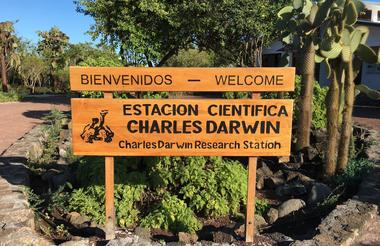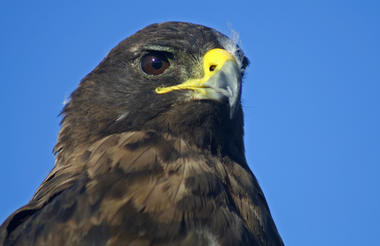Charles Darwin Research Station
This morning, you’ll visit the Charles Darwin Research Station on Santa Cruz Island. It’s a special place where scientists and park rangers work together to protect the unique animals and plants of the Galapagos. You’ll learn how they fight to save native species and keep out harmful ones.
One of the main highlights is seeing the giant tortoise breeding program, where these amazing creatures are raised and cared for before being released back into the wild.
As you walk through the station, you’ll be surrounded by native dry forest, full of tall cacti and interesting local plants. Keep an eye out for Darwin finches, playful flycatchers, and cheerful mockingbirds along the way.
Later in the day, you’ll begin your journey back to the mainland of Ecuador. It’s time to relax, think about everything you’ve seen, and say goodbye to the incredible Galapagos Islands. You’re leaving with unforgettable memories and a deeper understanding of nature and how important it is to protect it.
Morning: Takeoff to Baltra Airport
Your Galapagos adventure begins with your arrival at Baltra Airport. As soon as you land, a certified naturalist guide from the Galapagos National Park will be there to greet you and start your journey into one of the most unique places on Earth.
Afternoon: Exploring the Highlands
In the afternoon, you’ll take a scenic bus ride into the green highlands of Santa Cruz Island. Along the way, you’ll stop at a nature reserve where you’ll get the chance to see giant Galapagos tortoises roaming freely in the wild. These peaceful giants can weigh over 300 kg (600 pounds) and are often seen relaxing in ponds or slowly grazing in the grass.
As you explore, you’ll also spot highland birds that don’t live in the lowlands, like different types of finches, flycatchers, and waterbirds. If your schedule allows, you’ll also visit a lava tunnel — a natural cave formed by ancient volcanic eruptions. It’s a great place to learn about the islands’ volcanic origins.



Breakfast
Lunch
Dinner
Morning: Tintoreras
Start your day on Isabela Island by visiting Tintoreras, a group of small islets surrounded by clear blue water. As you sail through the area, look for white-tipped reef sharks, colorful fish, and starfish in the shallow waters.
Next, you’ll go on a hike across volcanic landscapes that look like the surface of the moon. Along the way, you’ll learn about the island’s volcanoes and its unique plants and animals.
Afternoon: Isabela Island Wetlands & Interpretation Center
In the afternoon, you’ll explore the wetlands of Isabela Island. Walk through trails that pass by mangroves, saltwater lagoons, and beaches. This area is great for birdwatching—keep your eyes open for flamingos, blue-billed ducks, and other water birds.
You’ll end the day at the Interpretation Center, where you’ll learn more about the Galapagos Islands’ nature, history, and the efforts to protect these amazing places for future generations.



Breakfast
Lunch
Dinner
Morning: Moreno Point
Your day starts at Moreno Point on Isabela Island, where you’ll walk across black lava fields that might seem empty at first—but are actually full of life. As you move inland, you’ll find shallow lagoons where flamingos, ducks, gallinules, and herons gather.
Along the shore, look out for Galapagos penguins, marine iguanas, flightless cormorants, blue-footed boobies, sea lions, and many kinds of shorebirds.
Afternoon: Mangle Point
In the afternoon, you’ll visit Mangle Point on Fernandina Island, one of the most untouched islands in the Galapagos. As your boat slowly cruises through the mangroves, watch for sea turtles and rays hiding among the tangled roots.
This peaceful spot is perfect for snorkeling. You’ll swim through calm, shallow water filled with sea turtles, rays, and lots of tropical fish.



Mangle Point
Breakfast
Lunch
Dinner
Morning: Espinoza Point
Your day starts at Espinoza Point, located at the base of one of the Galapagos’ most active volcanoes. This site is famous for its large colony of marine iguanas that greet you as soon as you arrive. The beach is also home to sea lions lounging around, with playful pups exploring the tide pools.
As you walk along the shore, look out for flightless cormorants, which are only found in the western part of the Galapagos. The waters here are full of nutrients, attracting many species, including herons, pelicans, oystercatchers, sea turtles, and shorebirds. Keep an eye on the mangroves too, where Galapagos hawks can often be seen hunting for prey.
Afternoon: Tagus Cove
In the afternoon, you’ll head to Tagus Cove, a historical site visited by Charles Darwin during his time in the Galapagos. As you explore the Palo Santo forests, look for Darwin finches and mockingbirds. The views from here are breathtaking, with a great panorama of Darwin’s Lake and the towering volcanoes of northern Isabela.
Take a boat tour along the shoreline to see penguins, cormorants, and marine iguanas. You may also spot the Galapagos martin, a small bird that’s very rare and considered one of the most endangered species on the island.



Breakfast
Lunch
Dinner
Morning: Egas Port
You’ll start the morning at Egas Port on Santiago Island. Despite the name, there isn’t a traditional port here, but you’ll see some old remnants from the 1960s when people tried to settle on the island.
The trail follows the coastline, which is full of wildlife. Everywhere you look, you’ll see marine iguanas soaking up the sun, along with sea lions, herons, oystercatchers, and many shorebirds. Towards the end of the trail, you’ll reach the grottos, where you may spot the elusive Galapagos fur seals—these seals are much harder to find than sea lions.
In 2019, land iguanas were reintroduced to the island after being absent for over 100 years, so keep your eyes peeled for these impressive reptiles as well.
Afternoon: Chinese Hat
In the afternoon, you’ll visit Chinese Hat, a small island separated from Santiago Island by a narrow channel. The island has a striking, symmetrical volcanic cone, surrounded by turquoise water, white coral sand beaches, and dark lava rocks.
As you walk along the shore, you’ll get up close to a small colony of sea lions, and you might even spot penguins, who thrive in this unique environment.



Breakfast
Lunch
Dinner
Morning: Black Turtle Cove
You’ll begin your last day in the Galapagos at Black Turtle Cove, a peaceful natural reserve named after the many green sea turtles (or “Tortugas negras”) that live here. You’ll explore the area by dinghy, gliding through calm water channels and mangrove forests.
During the ride, keep an eye out for reef sharks, rays, and a variety of birds like herons, pelicans, and boobies. Black Turtle Cove is not just a haven for sea turtles, but also an important breeding ground for them and a nursery for different shark species.
After this incredible morning, you’ll prepare to head back to the mainland of Ecuador, reflecting on all the amazing wildlife and unique places you’ve experienced during your Galapagos adventure.



Breakfast





